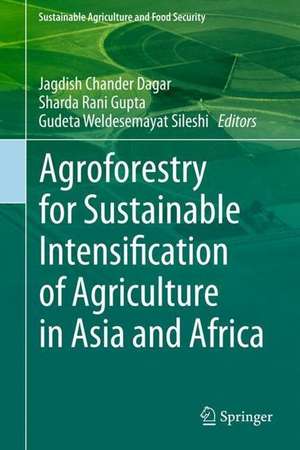Agroforestry for Sustainable Intensification of Agriculture in Asia and Africa: Sustainability Sciences in Asia and Africa
Editat de Jagdish Chander Dagar, Sharda Rani Gupta, Gudeta Weldesemayat Sileshien Limba Engleză Hardback – 20 apr 2023
This edited book opens up new vistas for sustainable intensification in agriculture to provide food to ever growing population as well as adapting to the risks of global environmental change. Diverting from conventional agriculture, the book explores new dimensions and concepts that have been identified for future research and development in sustaining agriculture in Asia and Africa regions. The chapters are written by leading researchers and practitioners in the field of agroforestry. The book demonstrates how agroforestry could be instrumental in bringing stability and sustainability in agricultural production. It offers sustainable solutions for the impending problems of climate change, ecosystem degradation, declining agricultural productivity, and uncertain food security. It is an essential resource for students in agroforestry courses, as well as a valuable introduction to the field for professionals in related areas.
Preț: 1412.36 lei
Preț vechi: 1722.39 lei
-18% Nou
Puncte Express: 2119
Preț estimativ în valută:
270.26€ • 282.88$ • 224.94£
270.26€ • 282.88$ • 224.94£
Carte tipărită la comandă
Livrare economică 31 martie-14 aprilie
Preluare comenzi: 021 569.72.76
Specificații
ISBN-13: 9789811946011
ISBN-10: 9811946019
Pagini: 816
Ilustrații: XXII, 816 p. 1 illus.
Dimensiuni: 155 x 235 mm
Greutate: 1.34 kg
Ediția:2023
Editura: Springer Nature Singapore
Colecția Springer
Seriile Sustainability Sciences in Asia and Africa, Sustainable Agriculture and Food Security
Locul publicării:Singapore, Singapore
ISBN-10: 9811946019
Pagini: 816
Ilustrații: XXII, 816 p. 1 illus.
Dimensiuni: 155 x 235 mm
Greutate: 1.34 kg
Ediția:2023
Editura: Springer Nature Singapore
Colecția Springer
Seriile Sustainability Sciences in Asia and Africa, Sustainable Agriculture and Food Security
Locul publicării:Singapore, Singapore
Cuprins
Part I: Progress Towards Sustainable Intensification and Climate Change.- Chapter 1. Introduction: Agroforestry for Sustaining the Global Agriculture in Changed Environment.- Chapter 2. Agroforestry Matches the Evolving Climate Change Mitigation and Adaptation Agenda in Asia and Africa.- Chapter 3. Farmer Managed Natural Regeneration in Africa: Evidence for Climate Change Mitigation and Adaptation in Drylands.- Chapter 4. Urban and Peri-urban Agroforestry to Sustain Livelihood and Food Security in the Face of Global Environmental Change and Epidemic Threats.- Part II. Landscape Restoration and Combating Desertification.- Chapter 5. Agroforestry for Climate Change Resilience in Degraded Landscapes.- Chapter 6. The Great Green Wall Initiatives and Opportunities for Integration of Dryland Agroforestry to Mitigate Desertification.- Chapter 7. Silvopastoral Systems on Degraded Lands for Soil Carbon Sequestration and Climate Change Mitigation .- hapter 8. Utilization of Saline and Other Poor-quality Waters to Sustain Agroforestry Production.- Chapter 9. Potential of Agroforestry Systems for Food Security, Climate Change Mitigation, Landscape Restoration and Disaster Risk Reduction in Nepal.- Part III: Biodiversity and Ecosystem Services.- Chapter 10. The Role of Agroforestry Systems for Enhancing Biodiversity and Provision of Ecosystem Services in Agricultural Landscapes in Southeast Asia.- Chapter 11. Potentials of Indigenous Fruit Trees in Enhancing Nutrition, Income and Biodiversity Conservation in African Agroforestry.- Chapter 12. Ethnic Homestead Gardens: Diversity, Management and Conservation.- Chapter 13. Agroforestry for Plant Diversity and Livelihood Security in Southwest Asia.- Chapter 14. Achieving Biodiversity Conservation, Livelihood Security and Sustainable Development Goals through Agroforestry in Coastal and Island Regions of India and South East Asia.- Chapter 15.Biodiversity and Ecosystems Services of the Agroforestry Systems of the Himalayan Region: An Overview .- Chapter 16. Soil Biodiversity and Litter Decomposition in Agroforestry Systems of the Tropical Regions of Asia and Africa.- Part IV: Analytical Approaches and Policy Perspective.- Chapter 17. Agroforestry Suitability Mapping: A Geospatial Approach for Quantifying Land Potential for Intensification.- Chapter 18. Agroforestry as a Climate-Smart Agriculture: Strategic Interventions, Current Practices and Policies.- Chapter 19. Agroforestry as a Key Intervention to Achieve Nationally Determined Contribution (NDC) Targets.- Chapter 20. Potential of Traditional Agroforestry Systems for Intensification of Agriculture and Meeting Global Goals: Lessons from Asia and Africa.- Chapter 21. A Framework for Analysing Spatial Patterns and Extent of Influence by Single Trees on Ecosystem Properties in Agroforestry.- Chapter 22. Integrating Moringa oleifera and Moringa stenopetala in Agroforestry for Adaptation and Mitigation of Climate Change in Asia and Africa.- Chapter 23. Payment for Ecosystem Services from Agroforestry: Case Studies and Lessons.- Chapter 24. Agroforestry for Sustaining Industrial Raw Materials: Experience from a Value Chain Leveraged Consortium Model.- Chapter 25. Synthesis: Agroforestry for Sustainable Intensification of Agriculture in Asia and Africa.
Notă biografică
Jagdish Chander Dagar
Former Assistant Director General in Natural Resource Management,
Indian Council of Agricultural Research
New Delhi, India
Former Assistant Director General in Natural Resource Management,
Indian Council of Agricultural Research
New Delhi, India
Sharda Rani Gupta
Botany Department, Kurukshetra University
Kurukshetra, India
Botany Department, Kurukshetra University
Kurukshetra, India
GW Sileshi
Institute of Environmental Studies, Addis Ababa University Addis Ababa
Ethiopia
Institute of Environmental Studies, Addis Ababa University Addis Ababa
Ethiopia
Textul de pe ultima copertă
This edited book opens up new vistas for sustainable intensification in agriculture to provide food to ever growing population as well as adapting to the risks of global environmental change. Diverting from conventional agriculture, the book explores new dimensions and concepts that have been identified for future research and development in sustaining agriculture in Asia and Africa regions. The chapters are written by leading researchers and practitioners in the field of agroforestry. The book demonstrates how agroforestry could be instrumental in bringing stability and sustainability in agricultural production. It offers sustainable solutions for the impending problems of climate change, ecosystem degradation, declining agricultural productivity, and uncertain food security. It is an essential resource for students in agroforestry courses, as well as a valuable introduction to the field for professionals in related areas.
Caracteristici
Highlights agroforestry as a problem-solving science for agricultural intensification Updates the field by explaining both Urban and peri-urban agroforestry Includes roles of soil microbiology and arthropods in sustaining agroforestry systems








